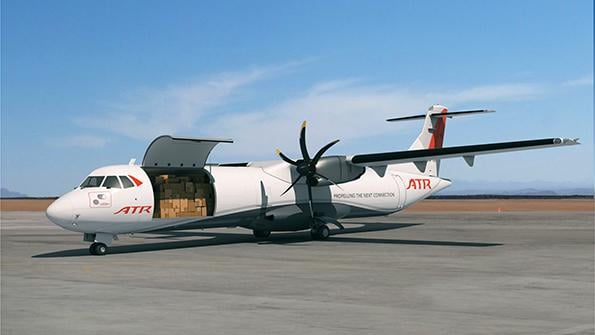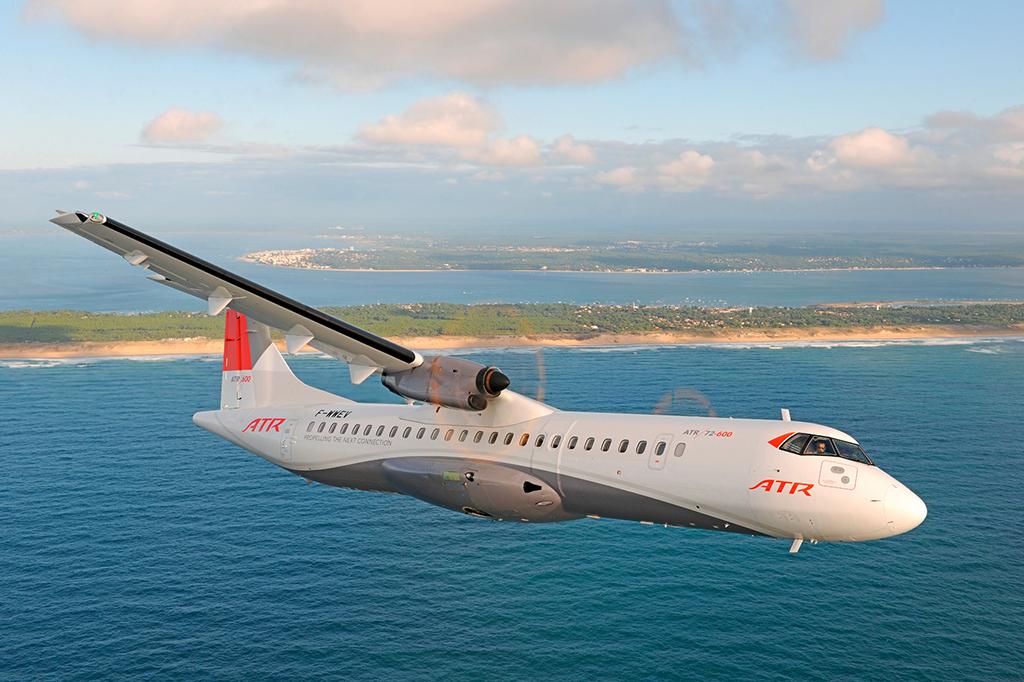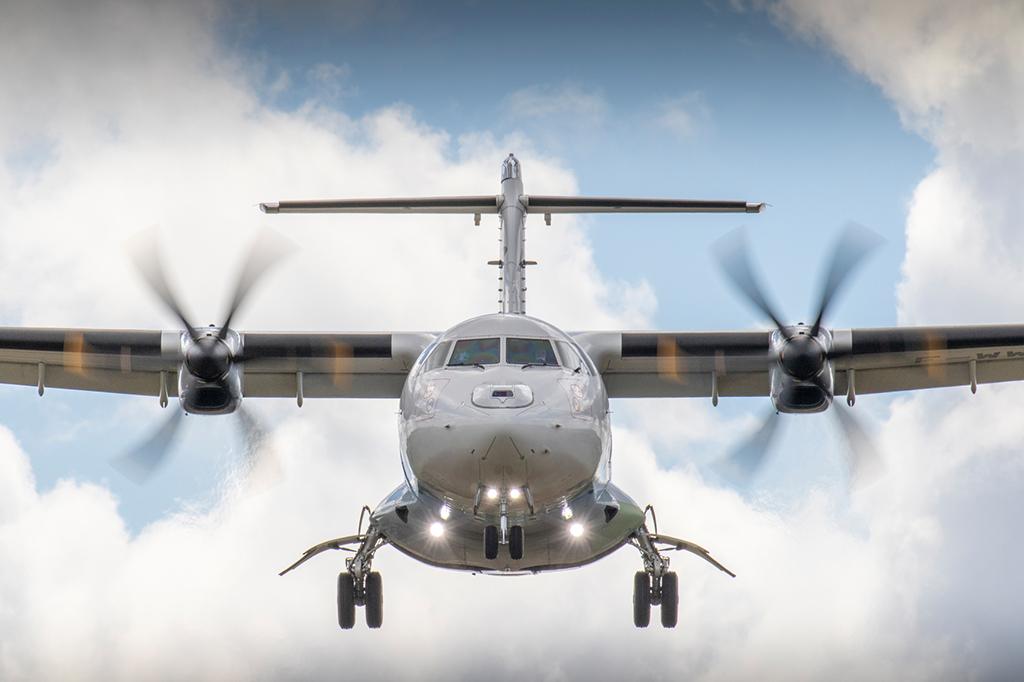
Regional turboprop manufacturer ATR is proceeding with a continuing effort to reduce the direct operating costs of the 70-seat-class ATR 72 despite an uncertain environment.
A number of ATR operators have been weakened, if not swept away, by the sharp traffic downturn accompanying the COVID-19 pandemic. ATR’s executives still want to see the silver lining of this cloud: Traffic involving ATR’s aircraft has been recovering better than most, they assert. Nevertheless, the financial health of their customers likely will remain fragile for a few years, meaning a glut of used aircraft on the market is possible.
The prospect of lower operating costs may help sustain residual value for ATR’s models, along with planned upgrades and new versions. The OEM has been striving to keep its lineup up to date, even though most competition has gradually vanished. De Havilland Aircraft of Canada has yet to confirm it intends to continue Dash 8-400 production.

Against that contrasting and unstable backdrop, the recent announcement by Airbus that it is studying three concepts for a hydrogen-fueled aircraft to be in service by 2035, including a turboprop, was seen as encouraging.
Meanwhile, airworthiness directives continue to affect ATR’s products, apparently without negatively impacting their consistently high dispatch reliability.
The pandemic crisis is making ATR engineers’ lives more complicated, but operators may expect unfailing support even so, says David Brigante, ATR’s senior vice president for programs and customer services. “We have tried to support them as much as possible. . . . Our customer support team was making calls on a weekly basis; we have tried to understand their issues,” he says. During the lockdown, engineers worked from home “and [ATR] continued to guarantee 24/7 customer support.”
And they followed through on a key project. “We are extending C check intervals to 8,000 flight hours, up from 5,000 flight hours,” Brigante says. The improvement is expected to be effective in the first quarter of next year. Company experts reviewed service data and determined that it could be done, he says.

The change is described as part of a continuing process aimed at offering lower direct operating costs (DOC) to operators. Overall, “we aim at a two-digit cut in DOC by next year or early 2022,” says Brigante. Another ingredient in the recipe is the new air conditioning system, which ATR asserts offers better performance and costs less to maintain.
Dispatch reliability stands at a stable 99.63% overall, according to Zuzana Hrnkova, ATR’s vice president for marketing. It is measured by region, by customer and by operating environment.
ATR has company-owned service centers in Toulouse (where it is headquartered), Bangalore (India), Miami and Singapore. A fourth, smaller service center is located in Auckland, New Zealand. One-third of the fleet is based in the Asia-Pacific region, Brigante notes.
The maintenance, repair and overhaul facility at Toulouse Francazal Airport takes care of services such as major structural repairs, if they are not performed at the customer’s location.
Spare parts distribution centers can be found in Auckland, Miami, Paris and Singapore. Regional support offices have been established in Sao Paulo, Brazil; Johannesburg, South Africa; and Brisbane, Australia.
A network of ATR-certified MRO service providers (also known as partner MROs) maintains proximity with the customer. “We audit them, supervise training and suggest tooling,” Brigante explains. The addition of one in China is a work in progress despite current travel restrictions.

Germany-based Rheinland Air Service (RAS) is one of ATR’s partner MROs. For an annual fee, RAS has access to a parts inventory, technical documentation and support from ATR, says Joerg Peters, director for regional maintenance.
ATR assigns work to RAS and may ask it to dispatch a mobile repair team. “We perform about 30 heavy maintenance checks on ATRs and receive 400-450 ATR work orders per year,” Peters reckons. Those numbers include both ATR models. RAS provides ATR with feedback on its products and market information.
ATR does not promote its partners’ names. “At the end of the day, you make your own reputation,” Peters adds. But at least some customers are reassured by ATR’s logo, and being part of the network helps maintain a good relationship with the OEM, he says.
“ATRs are the most reliable turboprops I know,” Peters answers when asked about the product from an MRO standpoint. “You have to focus on corrosion prevention on aerostructures,” he notes. Spare parts availability and pricing are considered good, notably thanks to an active second-hand market. RAS has parted-out more than 30 ATR airframes, he says.
The ATR brand also has a good reputation for maintainability and product support.
Air Corsica has operated ATR 72s for 30 years, and maintenance is done in-house. “In heavy checks, ATRs have relatively predictable needs. The number of manhours will not be too different if you compare one check to the next one, and you should not expect major unscheduled work before 12 years of service,” says Herve Pierret, a member of Air Corsica’s management board.
The carrier has measured dispatch reliability of its seven-strong fleet (six ATR 72s and one ATR 42) at 99%, “only slightly below that of a younger A320,” he says.
Pierret describes the ATR 72’s design as simple. However, it still requires attention, he says. Minor failures may happen frequently, but they are predictable—and they are often the same, he explains.
Such problems need to be resolved immediately. “But once you have understood the aircraft’s philosophy, it is easy to manage,” he says. “If you take care of the aircraft on a daily basis, if you have structured your organization for that, you get great regularity, you get a great aircraft.”
Struggling with a sudden, massive drop in demand, some ATR operators did not survive the downturn. Others are still under Chapter 11-type protection schemes, and some are still afloat only thanks to government support.
According to Aviation Week’s Fleet Discovery data, 490 ATR 72s are in service and 206 are in storage. Most-represented in the in-service fleet is the ATR 72-600—the latest version. The orderbook stands at 201, with the Asia-Pacific region accounting for the highest proportion, at 38%.
Aviation Week’s 2020 Commercial Aviation Fleet & MRO Forecast suggests average annual aircraft utilization for the ATR 72 was close to 2,100 flight hours before the crisis.
“Pre-crisis, ATR aircraft productivity was on average 25 cycles per week per aircraft. Today it is at around 18 cycles per week per aircraft, so our current productivity is 73% of what it was,” says an ATR representative. Those numbers are for the ATR 42/72 family—one in four ATR 72 operators also operates the ATR 42, its smaller sibling.
For some carriers, one vulnerability has been small size: The average ATR fleet stands at six aircraft. Carriers may operate other aircraft, but the number of ATRs is an indication of operator size. The smallest and largest ATR fleets are one- and 60-strong, respectively, according to Hrnkova.
However, since the pandemic crisis began, available seat-miles flown by ATRs have decreased later than they did for any other segment, have declined less and have been increasing more quickly, ATR utilization statistics indicate, based on data supplied by air traffic facts and figures specialist OAG. In the regional aviation sector, ATRs appear to be busier than regional jets and other turboprops.
The decrease in flying means less work for MRO service providers, but its less abrupt decline may be due to the variety of ATR operations, as well as the more diverse geographical footprint. “ATRs fly essential services; they are essential for communities when they carry food and medical supplies—plus, during the pandemic, repatriation flights,” says Hrnkova.
In Taiwan, Uni Air and Mandarin Air Lines have returned to pre-crisis traffic levels, notably thanks to local tourism, Hrnkova says. Around the Mediterranean, Sky Express, Binter Canarias and Air Corsica recorded traffic numbers for the August-September period comparable to winter levels, she adds. Globally, the growth of e-commerce, which translates into greater demand for cargo transportation, has not been slowed by the crisis.
Hrnkova also is seeing the beginning of a wave of replacements for ATR. This implies MRO service providers will transition to working on current-generation turboprops, instead of aircraft from the 1980s and ’90s. “Around 950 Western turboprops will retire over the coming years,” Hrnkova says. The wave is more related to the smaller ATR 42, as the aging 30-50-seaters have to find successors, she adds.
For example, Florida-based Silver Airways has received 10 ATR 42/72-600s. This is half of the order it placed—via lessor Nordic Aviation Capital—to replace its Saab 340Bs.
A Chinese order has thus far been a tantalizing goal. “Regional aircraft represent 3% of the Chinese fleet, far below the global average of 25%,” Hrnkova says. In 2017, two letters of intent were signed with small operators, but orders have yet to materialize.
The airframer is zeroing in on Civil Aviation Administration of China (CAAC) certification for the ATR 42-600. Last summer, representatives of the CAAC participated in a certification flight in Toulouse, alongside their European Union Aviation Safety Agency (EASA) counterparts.
Expect new versions and significant upgrades to enter service in the near future. The ATR 72-600F freighter the OEM has been developing will be delivered starting this year, as planned, according to company executives. Launch customer FedEx signed a firm order for 30, anticipating performance better than a cargo conversion of a used aircraft.
ClearVision, the first enhanced-vision system with a wearable display in commercial aviation, was to enter service last summer. But the launch customer, Guernsey-based Aurigny, had to delay the pilot training process due to the crisis.
The system is designed to make landing in bad weather possible more often, rendering flight schedules more dependable. Introduction is now hoped for in 2021.
Development of the short-takeoff- and-landing variant of the ATR 42 is in full swing, and certification is seen late in 2022. The manufacturer has received 20 firm orders for the new variant.
In the more distant future, ATR’s involvement in a project incorporating hydrogen-based propulsion has yet to be confirmed. The company is jointly owned by Airbus and Leonardo, and such a decision would be made at the shareholder level, which may take months.
But Airbus’ expectation that turboprop engines and a 100-seat capacity will be an option for the first hydrogen-fueled passenger aircraft indicates the relevance of turboprop technology and the importance of the regional segment, Hrnkova says.
In recent ATR 42/72 airworthiness directives, EASA has required inspections of main landing gears. Incorrectly installed bushings have been found, and the issue, if not detected, can cause the main landing gear to collapse, the agency says.
The same failure could also be caused by hinge pins with manufacturing defects, which thus have to be replaced. Problems with hinge pins have persisted for years.
A directive and an ATR service bulletin also were prompted by reports of interference and chafing between a propeller brake hydraulic pipe and an electrical wire bundle bracket screw installed in the underwing box of the right-hand engine nacelle. To avoid a fire on the ground, modification of the wiring assembly was required.
Electrical wiring modification was also mandated to avoid chafing on an electrical harness in the left-hand wing, and a wiring modification was also needed behind the overhead bins. Damage was found on an electrical harness bundle, due to chafing with an air duct clamp, which also had to be repositioned.
Finally, to prevent a seat-track failure in an emergency landing, inspections have to be conducted, after defects were found with the component.





